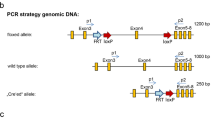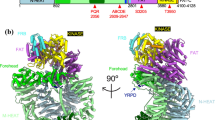Abstract
The Ku autoantigen/KARP-1 (Ku86 autoantigen related protein-1) plays an important role in the double-strand break repair of mammalian DNA as a DNA-binding component of DNA-dependent protein kinase (DNA-PK) complex. KARP-1 is differently transcribed from the human Ku86 autoantigen gene locus and it is implicated in the control of DNA-dependent protein kinase activity. We cloned rKAB1, a rat homolog of KAB1 (KARP-1 binding protein 1 of human) from a rat hippocampal cDNA library. rKAB1 mRNA was specifically expressed in the brain and the thymus. EGFP-tagged rKAB1 protein localized in cell nucleus and in the condensed chromosome during the mitotic cell division. We found that rKAB1 works as a protective protein against cell damage by oxidative stress.
Similar content being viewed by others
References
Gottlieb TM, Jackson SP: The DNA-dependent protein kinase: Requirement for DNA ends and association with Ku antigen. Cell 72: 131-142, 1993
Jeggo PA: DNA-PK: At the cross-roads of biochemistry and genetics. Mutat Res 384: 1-14, 1997
Nussenzweig A, Chen C, da Costa Soares V, Sanchez M, Sokol K, Nussenzweig MC, Li GC: Requirement for Ku80 in growth and immunoglobulin V(D)J recombination. Nature 382: 551-555, 1996
Zhu C, Bogue MA, Lim DS, Hasty P, Roth DB: Ku86-deficient mice exhibit severe combined immunodeficiency and defective processing of V(D)J recombination intermediates. Cell 86: 379-389, 1996
Gu Y, Jin S, Gao Y, Weaver DT, Alt FW: Ku70-deficient embryonic stem cells have increased ionizing radiosensitivity, defective DNA end-binding activity, and inability to support V(D)J recombination. Proc Natl Acad Sci USA 94: 8076-8081, 1997
Myung K, He DM, Lee SE, Hendrickson EA: KARP-1: A novel leucine zipper protein expressed from the Ku86 autoantigen locus is implicated in the control of DNA-dependent protein kinase activity. EMBO J 16: 3172-3184, 1997
Myung K, Braastad C, He DM, Hendrickson EA: KARP-1 is induced by DNA damage in a p53-and ataxia telangiectasia mutated-dependent fashion. Proc Natl Acad Sci USA 95: 7664-7669, 1998
Boveris A: Mitochondrial production of superoxide radical and hydrogen peroxide. Adv Exp Med Biol 75: 67-82, 1977
Badwey JA, Karnovsky ML: Active oxygen species and the functions of phagocytic leukocytes. Annu Rev Biochem 49: 695-726, 1980
Cao W, Carney JM, Duchon A, Floyd RA, Chevion M: Oxygen free radical involvement in ischemia and reperfusion injury to brain. Neurosci Lett 88: 233-238, 1988
Whittemore ER, Loo DT, Cotman CW: Exposure to hydrogen peroxide induces cell death via apoptosis in cultured rat cortical neurons. NeuroReport 5: 1485-1488, 1994
Whittemore ER, Loo DT, Watt JA, Cotman CW: A detailed analysis of hydrogen peroxide-induced cell death in primary neuronal culture. Neuroscience 67: 921-932, 1995
Dizdaroglu M, Nackerdien Z, Chao BC, Gajewski E, Rao G: Chemical nature of in vivo DNA base damage in hydrogen peroxide-treated mammalian cells. Arch Biochem Biophys 285: 388-390, 1991
Schraufstatter IU, Hyslop PA, Hinshaw DB, Spragg RG, Sklar LA, Cochrane CG: Hydrogen peroxide-induced injury of cells and its prevention by inhibitors of poly(ADP-ribose)polymerase. Proc Natl Acad Sci USA 83: 4908-4912, 1986
Zhang F, Xu S, Iadecola C: Time dependence of effect of nitric oxide synthase inhibition on cerebral ischemic damage. J Cereb Blood Flow Metab 15: 595-601, 1995
Suzuki T, Akaike N, Ueno K, Tanaka Y, Himori N: MAO inhibitors, clorgyline and lazabemide, prevent hydroxyl radical generation caused by brain ischemia/reperfusion in mice. Pharmacology 50: 357-362, 1995
Lancelot E, Callebert J, Revaud ML, Boulu RG, Plotkine M: Detection of hydroxyl radicals in rat striatum during transient focal cerebral ischemia: Possible implication in tissue damage. Neurosci Lett 197: 85-88, 1995
Globus MY, Busto R, Lin B, Schnippering H, Ginsberg MD: Detection of free radical activity during transient global ischemia and recirculation: Effects of intraischemic brain temperature modulation. J Neurochem 65: 1250-1256, 1995
Simonson SG, Zhang J, Canada AT, Su YF, Benveniste H, Piantadosi CA: Hydrogen peroxide production by monoamine oxidase during ischemia-reperfusion in the rat brain. J Cereb Blood Flow Metab 13: 125-134, 1993
Dawson VL, Dawson TM, Bartley DA, Uhl GR, Snyder SH: Mechanisms of nitric oxide-mediated neurotoxicity in primary brain cultures. J Neurosci 13: 2651-2661, 1993
Lafon-Cazal M, Pietri S, Culcasi M, Bockaert J: NMDA-dependent superoxide production and neurotoxicity. Nature 364: 535-537, 1993
Shackelford DA, Tobaru T, Zhang S, Zivin JA: Changes in expression of the DNA repair protein complex DNA-dependent protein kinase after ischemia and reperfusion. J Neurosci 19: 4727-4738, 1999
Woo RA, McLure KG, Lees-Miller SP, Rancourt DE, Lee PWK: DNA-dependent protein kinase acts upstream of p53 in response to DNA damage. Nature 394: 700-704, 1998
Chen J, Jin K, Chen M, Pei W, Kawaguchi K, Greenberg DA, Simon RP: Early detection of DNA strand breaks in the brain after transient focal ischemia: Implications for the role of DNA damage in apoptosis and neuronal cell death. J Neurochem 69: 232-245, 1997
Tobita M, Nagano I, Nakamura S, Itoyama Y, Kogure K: DNA single-strand breaks in postischemic gerbil brain detected by in situ nick translation procedure. Neurosci Lett 200: 129-132, 1995
Richardson SJ: Free radicals in the generation of Alzheimer's disease. Ann NY Acad Sci 695: 73-76, 1993
Olanow CW: An introduction to the free radical hypothesis in Parkinson's disease. Ann Neurol 32: S2-S9, 1992
Olanow CW: A radical hypothesis for neurodegeneration. Trends Neurosci 16: 439-444, 1993
Bellavite P: The superoxide-forming enzymatic system of phagocytes. Free Radical Biol Med 4: 225-261, 1988
Giulian D, Vaca K, Corpuz M: Brain glia release factors with opposing actions upon neuronal survival. J Neurosci 13: 29-37, 1993
Yamagata K, Andreasson KI, Kaufmann WE, Barnes CA, Worley PF: Expression of a mitogen-inducible cyclooxygenase in brain neurons: Regulation by synaptic activity and glucocorticoids. Neuron 11: 371-386, 1993
Irie Y, Yamagata K, Gan Y, Miyamoto K, Do E, Kuo CH, Taira E, Miki N: Molecular cloning and characterization of Amida, a novel protein which interacts with a neuron-specific immediate early gene product Arc, contains novel nuclear localization signals, and causes cell death in cultured cells. J Biol Chem 275: 2647-2653, 2000
Altschul SF, Gish W, Miller W, Myers EW: Basic local alignment search tool. J Mol Biol 215: 403-410, 1990
Linzer DI, Nathans D: Growth-related changes in specific mRNAs of cultured mouse cells. Proc Natl Acad Sci USA 80: 4271-4275, 1983
Robbins J, Dilworth SM, Laskey RA, Dingwall C: Two interdependent basic domains in nucleoplasmin nuclear targeting sequence: Identification of a class of bipartite nuclear targeting sequence. Cell 64: 615-623, 1991
Moll U, Lau R, Sypes MA, Gupta MM, Anderson CW: DNA-PK, the DNA-activated protein kinase, is differentially expressed in normal and malignant human tissues. Oncogene 18: 3114-3126, 1999
Koike M, Matsuda Y, Mimori T, Harada YN, Shiomi N, Shiomi T: Chromosomal localization of the mouse and rat DNA double-strand break repair genes Ku p70 and Ku p80/XRCC5 and their mRNA expression in various mouse tissues. Genomics 38: 38-44, 1996
Scheffner M, Werness BA, Huibregtse JM, Levine AJ, Howley PM: The E6 oncoprotein encoded by human papillomavirus type 16 and 18 promotes the degradation of p53. Cell 63: 1129-1136, 1990
Yin Y, Terauchi Y, Solomon GG, Aizawa S, Rangarajan PN, Yazaki Y, Kadowaki T, Barrett JC: Involvement of p85 in p53-dependent apoptotic response to oxidative stress. Nature 391: 707-710, 1998
Author information
Authors and Affiliations
Rights and permissions
About this article
Cite this article
Do, E., Taira, E., Irie, Y. et al. Molecular cloning and characterization of rKAB1, which interacts with KARP-1, localizes in the nucleus and protects cells against oxidative death. Mol Cell Biochem 248, 77–83 (2003). https://doi.org/10.1023/A:1024157515342
Issue Date:
DOI: https://doi.org/10.1023/A:1024157515342




